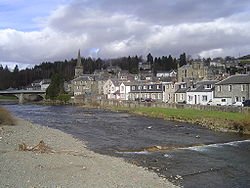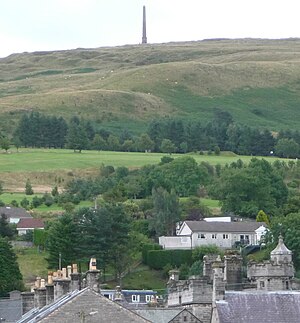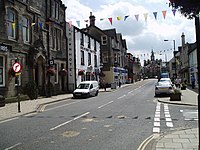Langholm
| Langholm | |
| Dumfriesshire | |
|---|---|
 Langholm and the River Esk | |
| Location | |
| Grid reference: | NY364847 |
| Location: | 55°9’7"N, 2°59’56"W |
| Data | |
| Population: | 2,311 ((2001)) |
| Post town: | Langholm |
| Postcode: | DG13 |
| Dialling code: | 013873 |
| Local Government | |
| Council: | Dumfries and Galloway |
| Parliamentary constituency: |
Dumfriesshire, Clydesdale and Tweeddale |
Langholm, also known colloquially as the "Muckle Toon", is a burgh in Dumfriesshire, on the River Esk and the A7 road.
Langholm is surrounded by four hills:
- Whita Hill, the highest, stands at 980 feet. On its summit stands an impressive obelisk commemorating the life and achievements of Sir John Malcolm (1769-1833), the distinguished soldier, statesman, and historian.
- Warblaw
- Meikleholmhill (a knowe of which is known as 'Tinpin') and
- The Castle Hill.

Arts & leisure
The unused episcopalian church on the Castle Holm in the town has been converted into the Armstrong clan museum.
The town is home to a music and arts festival, a food festival and the Langholm walks.
Each year many visitors come for the annual "Common Riding", which takes place on the last Friday of July.
Langholm has both a pipe band and a brass band (known as the Town Band - or colloquially as 'The Toon Ban'). The Town Band is the oldest surviving brass band in Scotland.
The town is also home to the Eskdale and Liddesdale Archaeological Society.
There is also an active Archive Group with a steadily increasing collection of information, much now on-line. [1]
Industry
Langholm has long been home to a thriving woollen milling trade and at one stage there were 22 mills in the town. There has been consolidation and closure since then, but many people still earn their living in the trade. The Edinburgh Woollen Mill, seen on many a high street, is based in Langholm.
Another local business is Border Fine Arts, set up in the early seventies. It makes figurines of local wildlife, each one hand painted by local people. The company trades around the world.

Armstrongs

The Armstrongs were one of the most powerful of the reiver families. Now the lawless days are long past, the Armstrongs still know Langholm as their home town.
Langholm as the traditional seat of the Clan Armstrong has a clan museum. The family is represented globally by the official Clan Armstrong Trust. Home of the Clan Armstrong line is Gilnockie Tower, 1½ miles north of Canonbie.
In 1972, the first man on the Moon, Neil Armstrong, was welcomed to the town, and made the first freeman of the burgh. He happily declared the town his home:
My pleasure is not only that this is the land of Johnnie Armstrong, rather that my pleasure is in knowing that this is my home town and in the genuine feeling that I have among these hills among these people.[2][3]
History
The town was an important centre for the Border Reivers.
In more peaceful later years, the town grew to prosperity around the textile industry, though it is now best-known as the birthplace of Hugh MacDiarmid and Thomas Telford.
The Langholm Project
The Langholm Project is a name for the Joint Raptor Study, a scientific study undertaken in the 1990s on Langholm moor into the effects of raptors on red grouse populations. This was a large scale project involving a range of organisations including the Game Conservancy Trust and Buccleuch estate. The project was followed by a two year study on the effects of supplementary feeding of harriers, which ended in 1999. The findings of the study and the effect on the moor have been the subject of much debate. In 2007 the Scottish Executive announced a further 10 year project with the following aims:
- to establish a commercially viable driven grouse moor. Within the time frame of the project, it is the intention to sell driven grouse days producing an annual income in excess of £100,000.
- to restore an important site for nature conservation to favourable condition
- to seek to demonstrate whether the needs of an economically viable grouse moor can be met alongside the conservation needs of protected raptors, especially the hen harrier.
The Langholm Project is a joint venture between Buccleuch Estates, Scottish Natural Heritage, the Game and Wildlife Conservation Trust, the RSPB and Natural England.